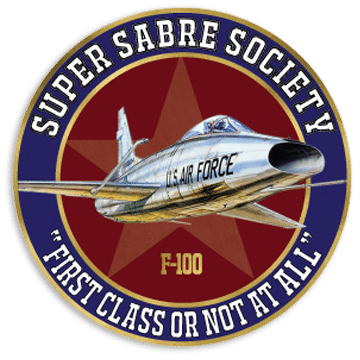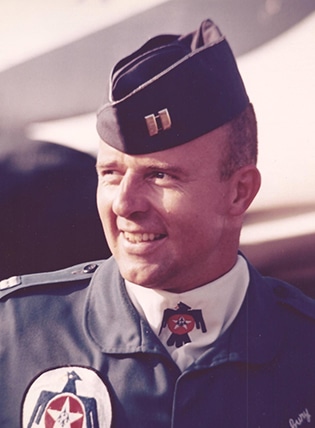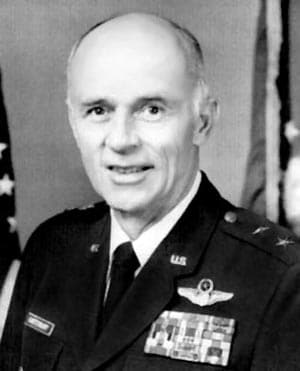Major General Henry D. Canterbury was the vice commander of 9th Air Force, Tactical Air Command, with headquarters at Shaw AFB, SC from February 1987 to his retirement in July of 1989.
General Canterbury was born in Huntsville, AL, in 1937. He graduated in the first class of the U.S. Air Force Academy, CO, in 1959 with a bachelor of science degree and earned a master’s degree in systems management from the University of Southern California in 1972. The general completed Armed Forces Staff College in 1972 and National War College in 1976.
Following his commissioning as a second lieutenant from the academy, he attended flight training at Spence AB, GA, and Vance AFB, OK, and received his pilot’s wings in July 1960. He then underwent F-100 combat crew training at Luke AFB, AZ, and Nellis AFB, NV. In July 1961 General Canterbury began a three-year tour of duty at Spangdahlem Air Base, West Germany, as an F-100 and F-105 pilot with the 9th Tactical Fighter Squadron, 49th Tactical Fighter Wing.
Returning to the United States in 1964, General Canterbury served with the 333rd Tactical Fighter Squadron at Eglin AFB< FL, flying F-105’s. The unit was assigned to the Tactical Air Warfare Center to test and evaluate tactics, procedures, and equipment concepts. In December 1964 the general moved to Nellis to fly F-100s in the slot position with the Air Force aerial demonstration team, the Thunderbirds. During his two years on the team, he flew in more than 230 air shows around the world.
En route to Southeast Asia, he completed the Fighter Weapons School at Nellis in July 1967 and then served a 12-month tour of duty with the 3rd Tactical Fighter Wing at Bien Hoa AB, Republic of Vietnam. While there he was chief of the Weapons and Tactics Division and flew 286 combat missions in F-100s.
In July 1968 he was assigned to Headquarters U.S. Air Force, Washington, D.C., as an action officer with the deputy chief of staff for plans and operations, Directorate of Operations. He then moved to Lindsey Air Station, West Germany, as executive officer to the vice commander in chief of U.S. Air Forces in Europe. From September 1970 to June 1971 General Canterbury was the executive officer to the commander of Air Training Command at Randolph AFB, TX.
After graduation from the Armed Forces Staff College, Norfolk, Va., in June 1972, he served successively with the 31st Tactical Fighter Wing at Homestead AFB, FL, as a flight commander, operations officer, and commander of the 308th Tactical Fighter Squadron. In 1972-1973 the squadron was on temporary duty for six months to Ubon Royal Thai AFB, Thailand, where he flew 90 more combat missions in F-4E’s.
In July 1976 the general completed the National War College, Fort Lesley J. McNair, Washington, D.C. He then returned to Air Force headquarters as assistant deputy director for combat readiness in the Directorate of Operations and Readiness. He became vice commander of the 4th Tactical Fighter Wing at Seymour Johnson AFB, NC, in June 1978 and, in July 1979, moved to MacDill AFB, FL, as commander of the 56th Tactical Fighter Wing. Under his command, the wing converted to F-16s.
General Canterbury transferred to Luke in January 1982 and took command of the 26th Air Division and 26th North American Aerospace Defense Command Region. The general became commander of Tactical Air Command’s 832nd Air Division at Luke in May 1982. Appointed deputy commander in chief of U.S. Southern Command, Quarry Heights, and commander, U.S. Air Force Southern Air Division, Howard Air Force Base, Panama, in December 1984, he was responsible for U.S. Air Force matters in Latin America and was the Joint Chiefs of Staff representative to those Air Forces.
A command pilot, General Canterbury has logged more than 5,000 flying hours in F-100s, F-105s, F-4s, F-16s, F-15s, and A-10s. His military decorations and awards include the Defense Superior Service Medal, Legion of Merit with oak leaf cluster, Distinguished Flying Cross with oak leaf cluster, Bronze Star Medal, Meritorious Service Medal and Air Medal with 20 oak leaf clusters.
He was promoted to major general Aug. 1, 1985, and retired from the USAF on July 1, 1989.
(source: https://www.af.mil/About-Us/Biographies/Display/Article/107493/major-general-henry-d-canterbury/)
Hank Canterbury – Caterpillar Story
The first time I went to Vietnam was 1967. I flew 286 missions in the first year I was over there. There was one incident during my time there where I had to jettison the airplane, sometimes known as “ejection”.
I was in the F-100 and two of us went out [2 aircraft], and to get under the weather we had to go out over the South China Sea a little bit. We came back in about 2500 ft under the undercast.
My engine just decided it had had enough, so it just quit. I’m heavily loaded with bombs and what have you, and low to the ground. I said, “this isn’t going to work!”. I turned about 90 degrees and jettisoned all the bombs and the fuel tanks from underneath the wing. The aircraft was sinking so I tried some procedures to get the aircraft running again, none of which worked. I did another turn to get back out over the water (if I could).
I looked up and saw how low I was and thought, it’s time to jettison this airplane! I reached down and blew the canopy and jettisoned the aircraft. I came out did a back somersault, the parachute opened and I hit the water.
I was fortunate that at least I was in the water which gave me a little protection from somebody coming at me, which they did. But, I had some support overhead which scared them off and I had my trusty .38 pistol which I showed to them. I don’t know if that had any effect on them.
I was picked up, finally, after about an hour in the water, and I made it out. It was kind of an exciting time.
(Excerpted from an interview with Lightspeed Executive Vice President and instrument-rated private pilot, Teresa De Mers, titled “A Lifetime of Flying and Serving with Hank Canterbury”. https://www.youtube.com/watch?v=8Dr4GXcdy68&feature=youtu.be)









